Planetary-mass objects
in the sigma Orionis cluster
José A. Caballero and Víctor J. S. Béjar
Instituto de Astrofísica de Canarias

On behalf of the JOVIAN Collaboration, a team of investigators from Spain (IAC, LAEFF-INTA) and Germany
(MPIA, TLS-T), we will briefly
describe part of our efforts to characterize the mass function
in the substellar domain and to search for objects with masses down to a few
Jupiter masses.
Our studies focus on the sigma Orionis cluster, a nearby (about 350 pc) young
(2-4 Myr) star-forming region in the Orion Belt.
Introduction
Substellar objects: brown dwarfs and exoplanets
Substellar objects do not burn the lightest isotope of hydrogen in a stable way
as stars do.
Theoretically predicted in the mid of the twentieth century, brown dwarfs are
substellar objects but have, however, enough mass to burn deuterium in their
interiors.
According to several authors, brown dwarfs have masses between 75 and 13 Jupiter
masses (MJup) for solar metallicity (1 solar mass is about 1000
MJup).
Since the discovery of the first brown dwarfs by direct imaging ten years ago,
Teide 1 (Rebolo et al. 1995) and GJ 229B (Nakajima et al. 1995), many other
substellar objects have been identified with masses spanning from the substellar
limit down to the planet-brown dwarf borderline. By 2005,
hundreds of brown dwarfs are known to populate young open clusters
(as the Pleiades, Chamaeleon, Ophiuchus or sigma Orionis), the solar
neighbourhood (detected by all-sky surveys as DENIS or 2MASS), and the
surroundings of stars (brown dwarfs also appear as companions to stars).
Brown dwarfs can be understood as the bridge between the least massive stars and
the most massive exoplanets.
Exoplanets do not have enough mass to burn deuterium in their interiors.
They have a mass below the deuterium burning mass limit, at about 13
MJup.
In the same year the first brown dwarfs were detected, the first giant exoplanet
orbiting a main sequence star was discovered via the radial velocity method, 51
Peg b (Didier and Queloz 1995).
To date, more than 150 candidates have been detected using this method and the
transit method, with minimum masses from about a dozen Jupiter masses down
to a few Earth masses (see the most recent exoplanet list at The
Extrasolar Planets Encyclopaedia).
However, objects with masses of several Jupiter masses were not
detected directly by imaging until this decade, both isolated in
young clusters (Zapatero Osorio et al. 2000; Lucas and Roche 2000) or in orbit
around a brown dwarf in a young stellar association (Chauvin et al. 2004).
In the last few years, there have been a spate of observations of objects with
masses below the deuterium burning mass limit in
young clusters and star-forming regions.
In general, they are detected free floating, not gravitationally bounded to any
star. For that reason, sometimes they are also called cluster planets
or isolated planetary-mass objects .
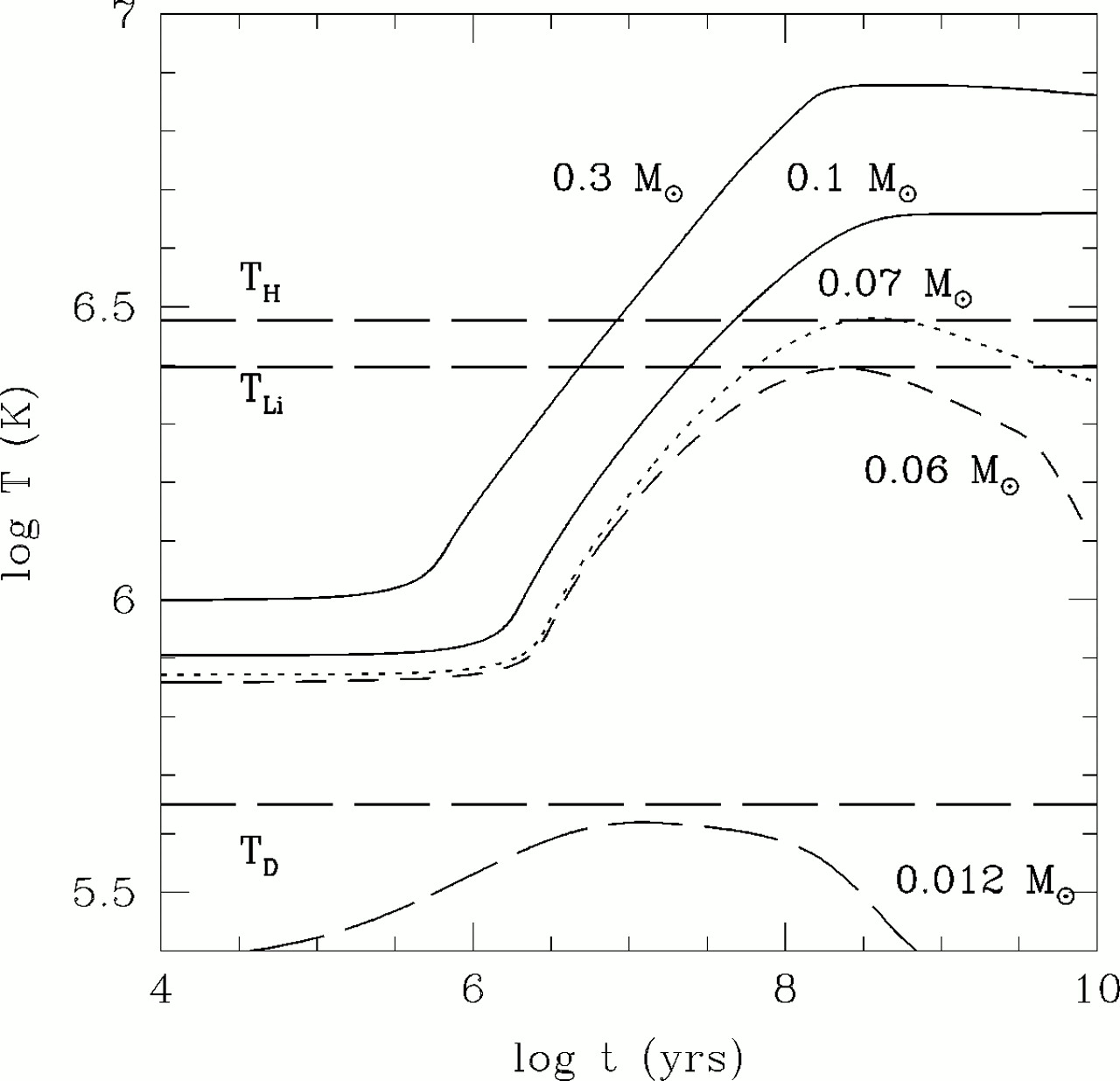
Figure 1:
Temperature in the centre as a function of the age for five objects with solar
metallicity and different masses (labeled in solar masses).
Horizontal lines denote the temperatures of burning of hydrogen (TH),
deuterium (TD) and lithium (TLi).
This figure can be found in the review of theory of low-mass stars and
substellar objects by Chabrier and Baraffe (2000).
How do planetary-mass objects form?
It is not clear how isolated planets are formed.
Several mechanisms for forming planetary-mass objects have been proposed:
(i) direct collapse and fragmentation of a molecular cloud, independently
of stars, as an extension of the stellar formation mechanism towards very low
masses;
(ii) by gravitational instabilities in protoplanetary discs around stars,
being ejected due to gravitational interactions with other members of the
planetary system or with other nearby systems during early stages of formation;
(iii) accretion stop or photo-erosion of pre-existing cores due to strong
ionising radiation coming from high-mass early-type stars;
(iv) dynamical ejection of a protostellar embryo from its placental
prestellar core.
The observations that we present here can shed light on this matter.
The importance of being young
The luminosity of substellar objects strongly depends on mass and age: they are
fainter and cooler when older and less massive.
As can be seen in the next figure, an object of about 10 MJup at an
age of only a few megayears is as bright as a solar-age low mass star of about
0.1 solar masses.
Hence, planetary-mass objects can be easily detected in nearby young open
clusters and associations.
The reader may also note that the 10-MJup object, at an age similar
to that of the Sun (about 4.6 Gyr), would have a luminosty 10-4 times
the luminosity of the least massive stars with solar-like age.
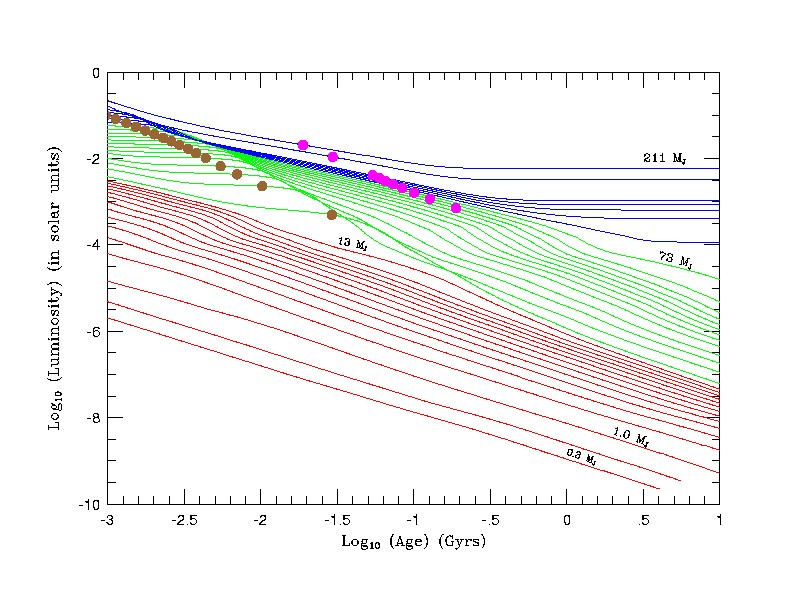 Figure 2:
Evolution of luminosty with age for a grid of objects in the stellar (blue),
brown-dwarf (green) and planetary (red) mass domains.
Brown and pink points denote when the deuterium and the hydrogen burning
finishes, respectively.
This figure and other very interesting ones can be found at Adam Burrows' Home Page.
Figure 2:
Evolution of luminosty with age for a grid of objects in the stellar (blue),
brown-dwarf (green) and planetary (red) mass domains.
Brown and pink points denote when the deuterium and the hydrogen burning
finishes, respectively.
This figure and other very interesting ones can be found at Adam Burrows' Home Page.
The sigma Orionis cluster
The sigma Orionis star is well known for amateur astronomers, as it is one of
the stars that illuminate the Horse Head Nebula.
In fact, it is at least a quintuple stellar system of early-type (O, B,
A) stars.
The existence of a population of low-mass stars surrounding the system is known
since the end of the nineties, when Wolk and Walter discovered an overdensity of X-ray sources in
the region.
To date, the young sigma Orionis cluster has become a cornerstone in the
substellar field.
The sigma Orionis cluster belongs to the Ori OB1b Association and is located at
a distance of 360+/-70 pc.
The most probable age is between 2 and 4 Ma.
Zapatero Osorio et al. (2002a) determined that the maximum and minimum ages of
the cluster are 8 and 1 Ma, respectively.
Extinction is negligible (the average AV is less than 1)
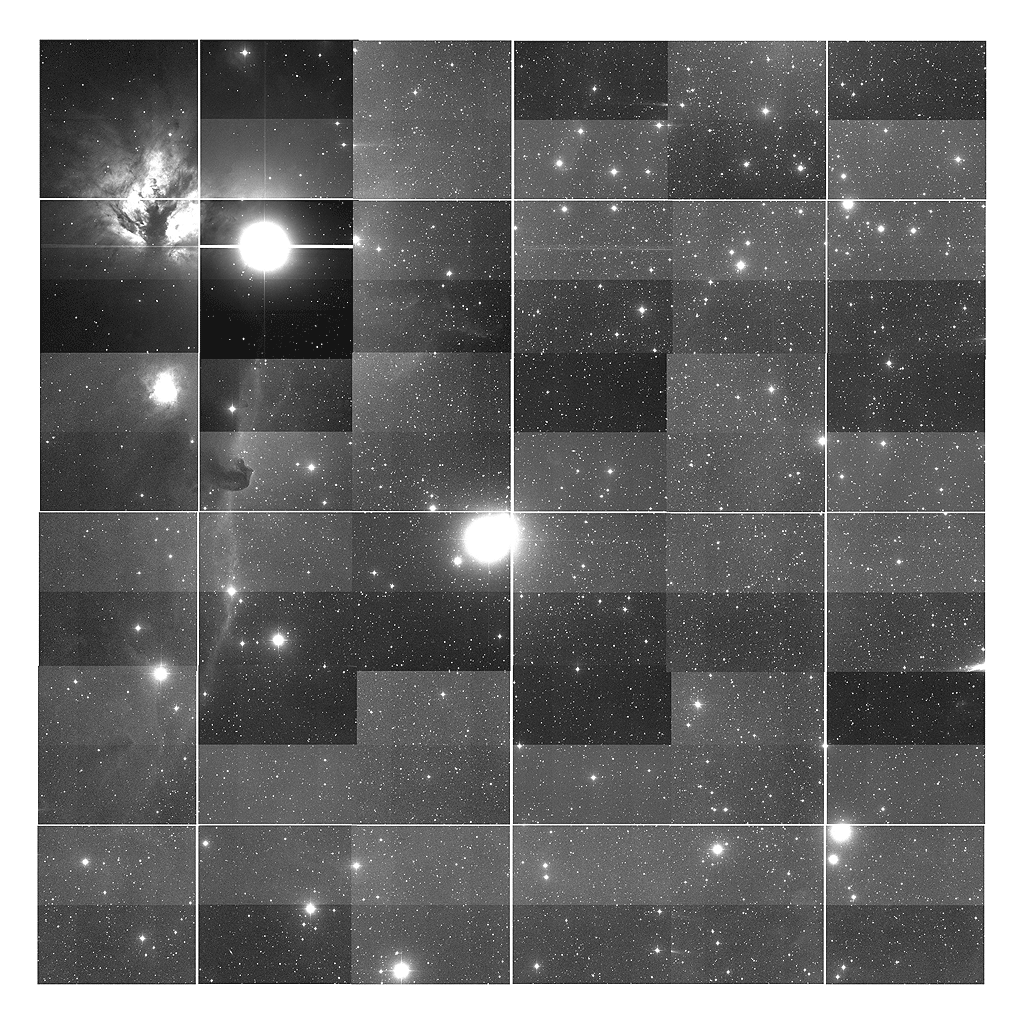
Figure 3:
Mosaic of white light centred in the multiple OB stellar system sigma Orionis.
North is up and east to the left left.
Approximate size is 90 times 90 arcmin2.
Bright star to the northeast of the field of view is Alnitak, the eastern bright
star of the Orion Belt.
Note the Horse Head Nebula to the east of sigma Orionis.
The images were taken with the European Space Agency Orbital Ground Station at the Observatorio del Teide.
Our first spectro-photometric sudies in the sigma Orionis cluster (Béjar et al. 1999; Zapatero Osorio et al. 1999)
allowed us to establish the photometric and spectral sequences of brown dwarfs
with types ranging from M6 to L1.5 (Teff between 3000 and 2000 K),
i.e. the whole brown-dwarf mass domain between 75 and 13 MJup.
Our deepest surveys have revealed the presence of cluster candidates with
planetary masses, which are isolated from stars (Zapatero Osorio et al. 2000; Caballero et al. in prep).
Follow-up optical and near-infrared spectroscopic observations carried out with
the Keck and VLT telescopes (Martín et al. 2001; Barrado y Navascués et
al. 2001; Zapatero Osorio et al. (2002a)) have confirmed the very likely
substellar nature of over a dozen of our planetary-mass candidates.
These objects display spectral classes ranging from early-L down to
mid-T, which corresponds to surface temperatures in the interval
Teff between about 2000 and 1000 K.
Our studies of the substellar mass function in sigma Orionis reveal
that the number of objects per mass interval increases towards the
lowest masses, the trend being described by the exponential
law dN/dM = a M-alpha, alpha ~ 0.8, (Béjar et al. 2001). This behaviour,
that seems to extend down to the planetary-mass domain, is not
exclusive of the sigma Orionis cluster.
Other studies carried out by other groups in Orion, the Pleiades, Chamaeleon or
IC 348 suggest that the formation of substellar objects is quite common.
The estimated mass of our faintest candidate in the sigma Orionis
cluster, S Ori 70, is 2-8 MJup (Zapatero Osorio et al. 2002b).
S Ori 70 has been classified as a T5.5+/-1.0 young dwarf and has an effective
temperature of about 1100 K.
It is very faint (J = 20.28+/-0.10) and displays quite red I-J
and blue J-Ks colours and strong methane bands at 1.6 and 2.3
10-6 m, typical of objects with T spectral type.
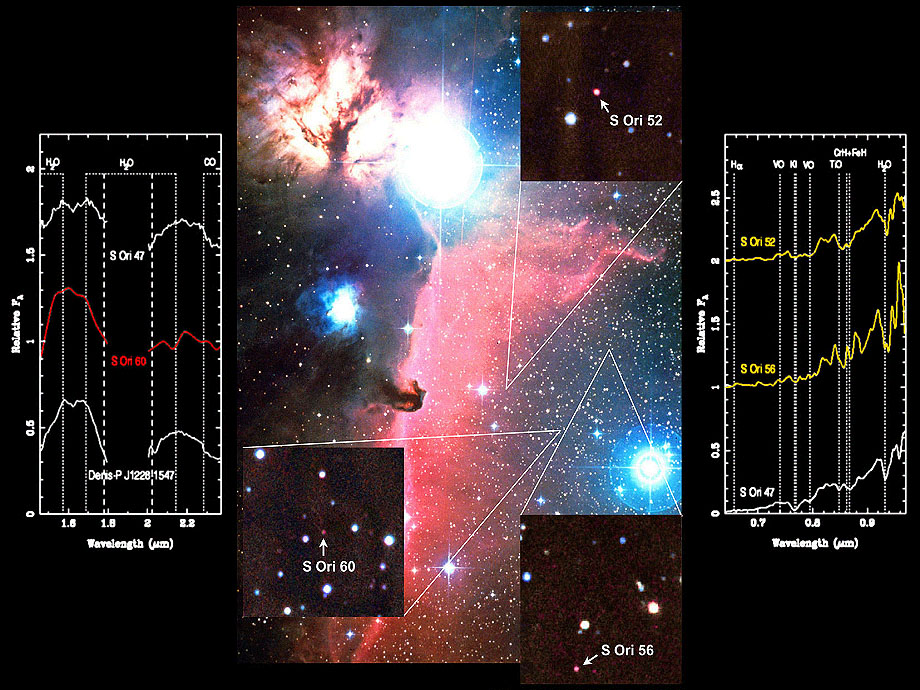
Figure 4:
Combined images, location in the sky, optical and infrared spectra and
pictorical view of several candidates to isolated planetary mass objects
detected by Zapatero Osorio et al. (2000).
Observations and analysis
The IJ survey
The JOVIAN Collaboration has performed a new very deep photometric survey in the
IJ bands to the southeast of the centre of the sigma Orionis cluster.
We have obtained photometric data using the Wide Field Camera at the 2.5 m Isaac
Newton Telescope in the I band (2000 Dec.) and with the ISAAC
spectrograph and camera at the Very Large Telescope UT1 in J band (2001
Dec.).
The overlapping area between the optical images and the near infrared images was
790 arcmin2.
It represents about 30 % of the total area of the cluster.
Completeness and limiting magnitudes in each set of images are about 23.4 and
24.0, and 20.6 and 21.8, respectively.
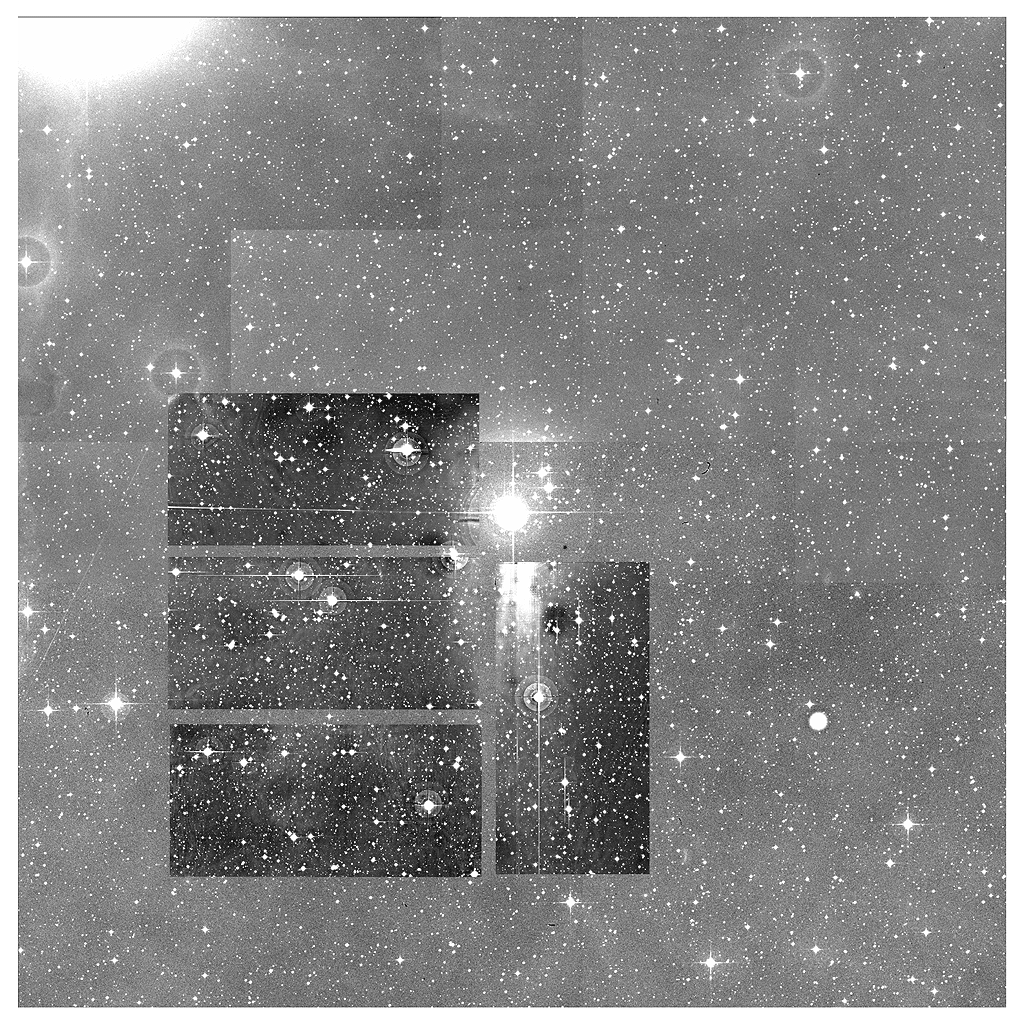
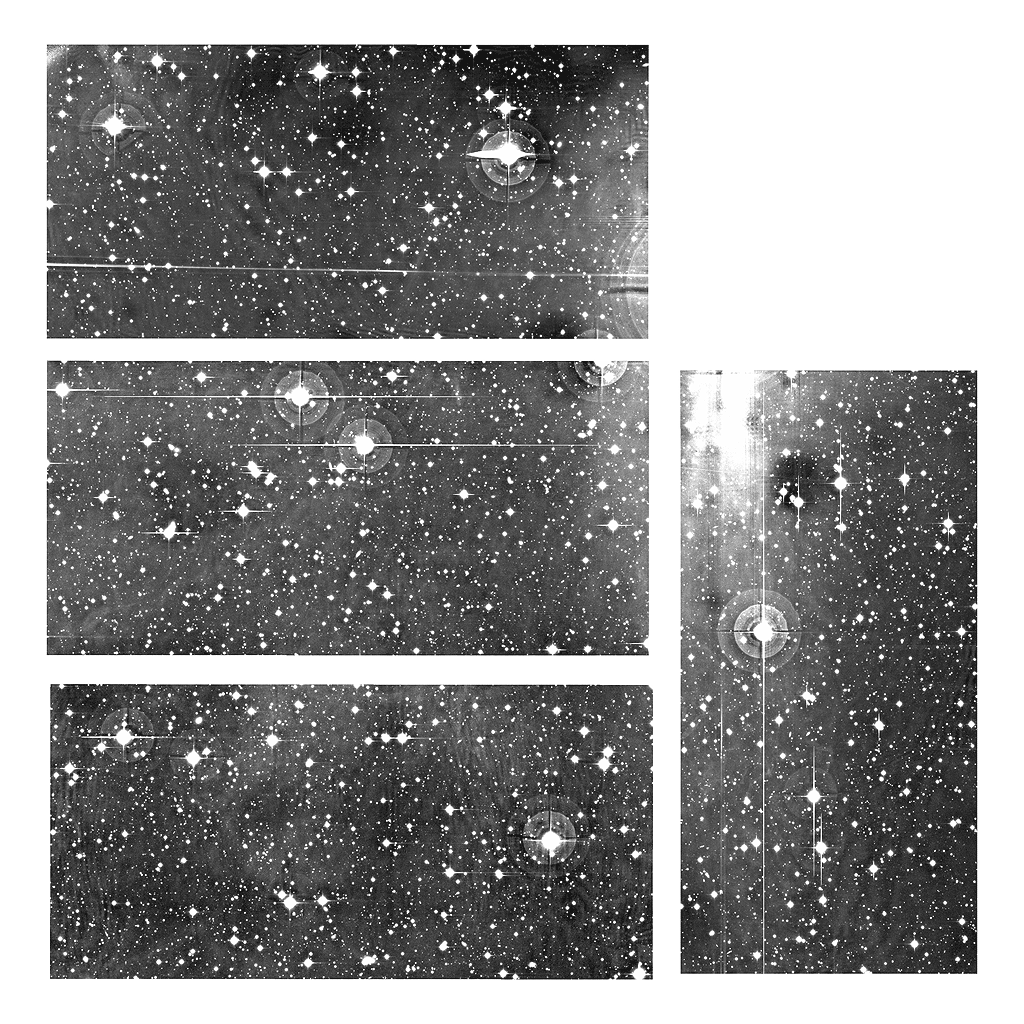
Figure 5:
Optical mosaics.
To the left: the I-band WFC images onto Digitised Sky Survey-2-IR plate
centred in the centre of the sigma Orionis cluster.
To the right: a zoom of the WFC images.
Size of each chip is about 11 times 22 armin2.
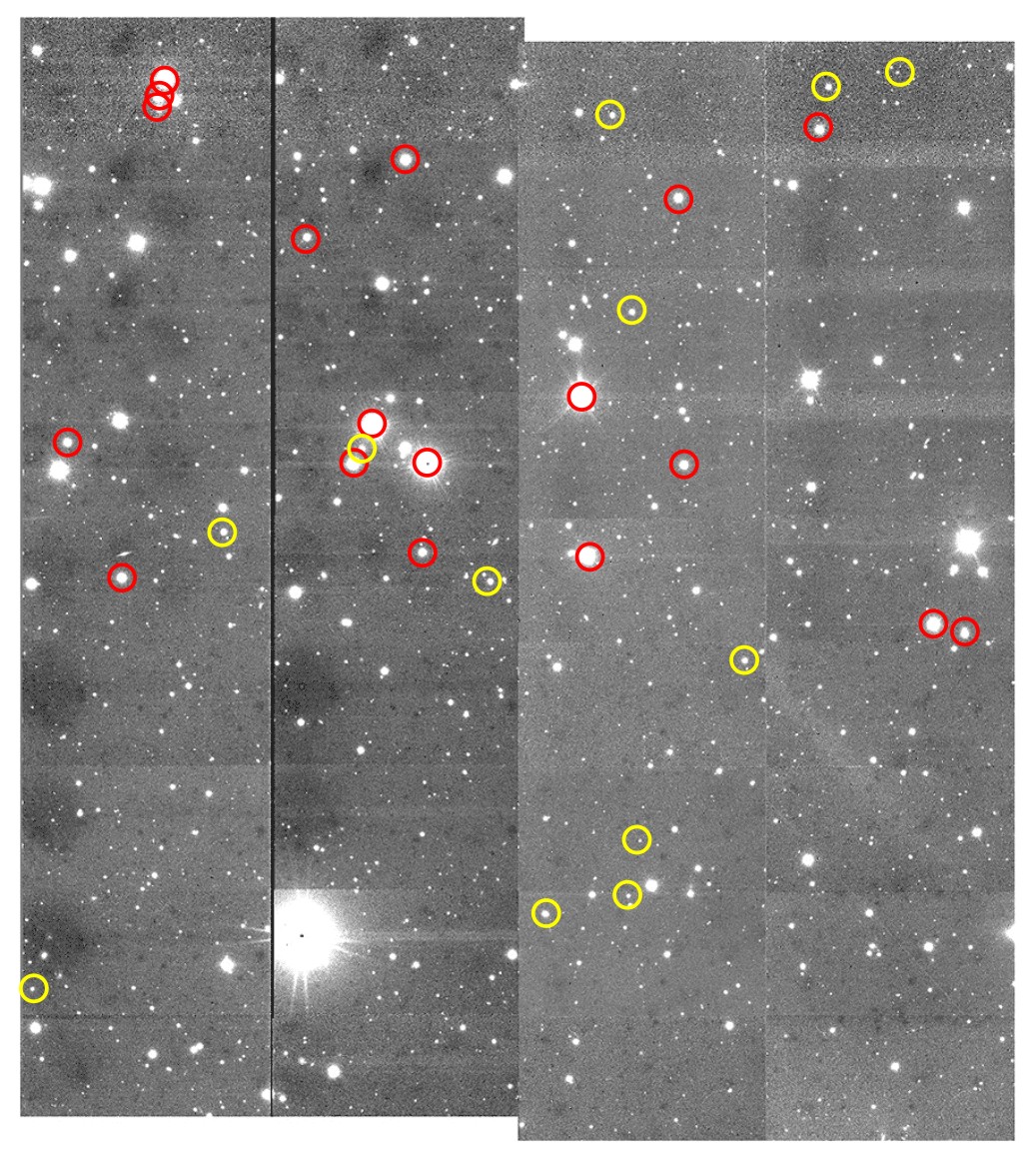
Figure 6:
J-band image of about 1/7 of the surveyed area.
This drif-scanned region corresponds to the north half of the vertical detector
of the Wide Field Camera (the southwestern one).
Stars that presumably belong to the cluster, based on colour and/or
spectroscopic data, are marked with red circles, and substellar object
candidates detected in our search are marked with yellow circles.
Selection
We have reduced the images, performed aperture and PSF photometry (using standard
IRAF tasks) and searched the optical counterparts of the near-infrared sources.
After the magnitude and astrometic calibrations and the IJ correlation,
I- and J-band magnitudes and equatorial magnitudes for about 10000
sources were available.
All the selected cluster member candidates were redder for a given magnitude
than a semiemprirical 10-Myr isochrone drawn in thick solid red line in the
clour-magnitude I vs. I-J diagram depicted in the next Figure.
The isochrone is the lowe envelope of previously confirmed mebers of the sigma
Orionis cluster, and it was previously used in Béjar et al. (2004).
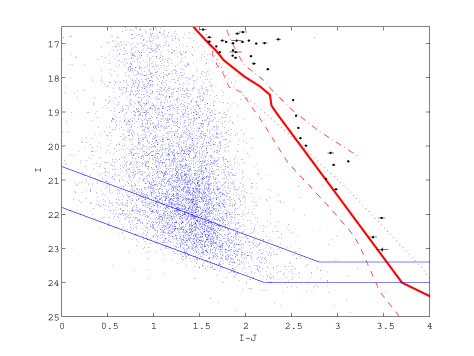
Figure 7:
Colour-magnitude I vs. I-J diagram with all the correlated
objects, automatically detected in both I- and J-band images.
Selected objects are marked with black dots and error bars.
Background and foreground objects that probably do not belong to the cluster are
marked with blue small dots.
NextGen (dot-dashed), Dusty (dotted) and Cond (dashed) 10-Myr isochrones at the
distance of the cluster are indicated in red.
Thick solid red line is the 10-Myr semiempirical isochrone used as selection
criterium.
Blue lines denote the completeness and limiting magnitudes of our search.
The HK-band follow-up
In order to asses that the IJ-selected objects have near infrared colours
typical of late M and L dwarfs, and to discriminate them from reddened stellar
sources or high-redshift galaxies, we used the instruments
Omega-2000 (O2K) at the 3.5-m Calar Alto Teleskop and CFHT-IR at the
Canada-France-Hawai'i Telescope to perform an HK follow-up.
We did imaging in H and Ks imaging during two O2K campaigns
(both of them were hampered by poor weather).
During the first run, we covered in H band more than 95 % of the IJ
survey area.
Limiting magnitude was Hlim = 18.1.
Two pointings with O2K (470 arcmin2, about 50 % of the area, but
containing most of the IJ cluster member candidates) in the H and
Ks bands were performed during the second campaign, reaching fainter
limiting magnitudes (down to Kslim = 20.0 in one of the
pointings!).
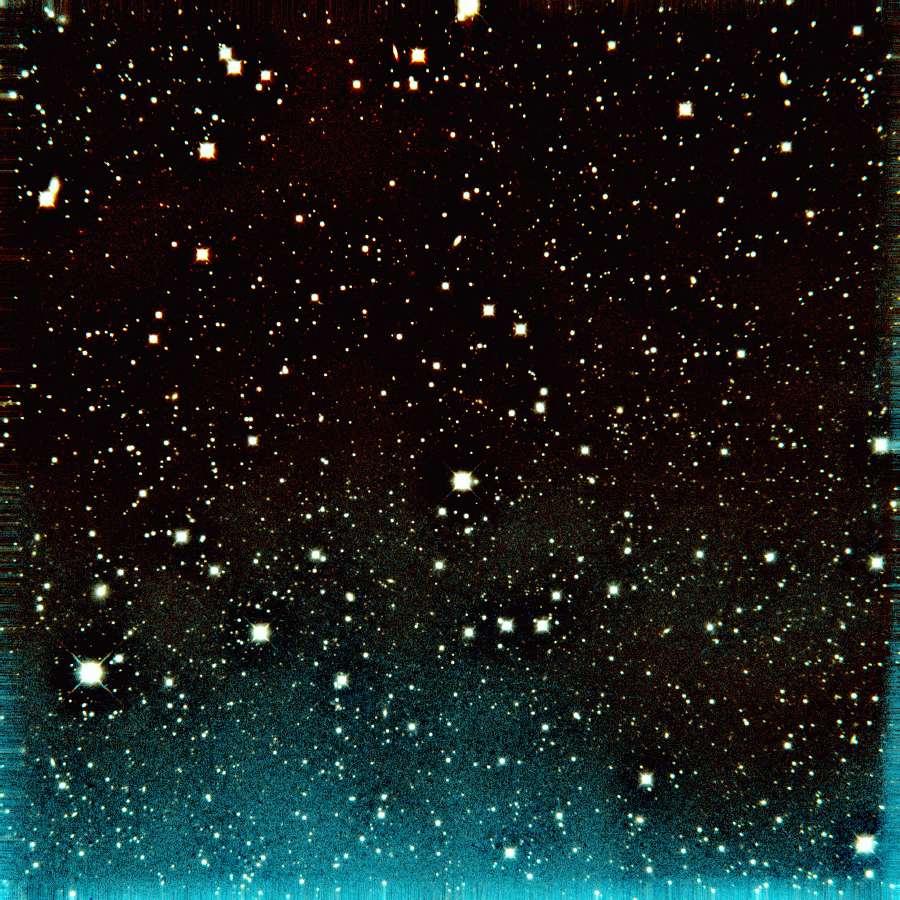
Figure 8:
False colour HKs-band combined image of one of the pointings during our
second run with O2K.
Size is 15.4 times 15.4 arcmin2.
Blue nebulosity to the south of the field of view is an artifact due to the long
time exposure used in the H-band observations (3 s each individual
image).
Results
A total of 39 cluster member candidates in the substellar mass domain have
arised from our deep survey and follow-up.
They have I- and J-band magnitudes in the range 16.5 to 22.8 and
14.5 to 19.5, respectively.
Out of them, about 25 objects had been detected in previously published surveys
(Béjar et al. 1999, 2001, 2005; Kenyon et al. 2005).
We have spectroscopic data for 19 objects that confirm that they belong to the
spectroscopic sequence of the cluster.
Most of them show spectroscopic features common to very young low-mass
objects (Li I in absorption, strong Halpha emission, other metallic lines in
emission, weak Na I absorption lines).
Several of them also show near-infrared excesses and strong photometric
variability, as Classical T Tauri stars do.
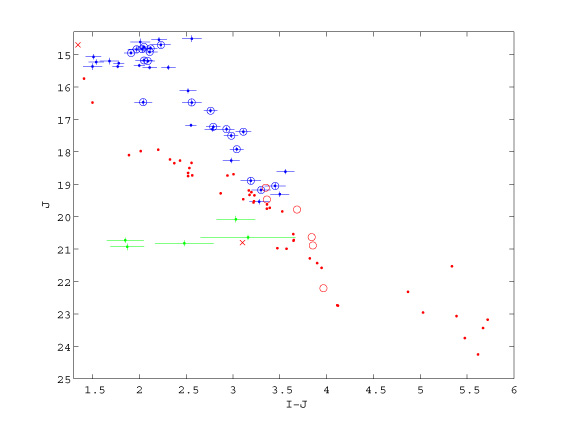
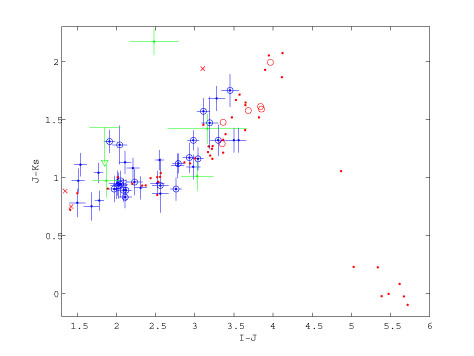
Figure 9:
Left: the J vs. I-J colour magnitude diagram.
Selected objects are shown in blue dots with error bars.
Encircled dots indicate that the object has spectroscopic data.
Red symbols represent field ultracool dwarfs with known parallax and measured
I at the distance of sigma Orionis.
Red dots, circles and crosses indicate normal, binary and peculiar dwarfs,
respectively.
Green dots with error bars represent near infrared sources in our search which
optical counterparts were not automatically detected.
Right: same as before, but the J-Ks vs. I-J colour-colour
magnitude.
We have derived a mass spectrum (dN/dM ~ M-alpha) after computing the
mass for each substellar object.
For the computation, we have used the mass-luminosity relation offered by the
state-of-the-art theoretical models of the Lyon group (Baraffe et al. 1998, 2002; Chabrier et al. 2000) and the relation between the B.C.J
bolometric correction and the I-J colours of the field ultracool dwarfs
with known parallax.
The most probable masses for each object range between about 80 and 7 Jupiter
masses.
The slope of the mass spectrum in this mass range, alpha = -gamma, is about
0.4-0.6 taking into account the contribution of the possible contaminants in the
sample (Salpeter slope in the stellar domain is 2.35).
In other words, the mass function is still increasing towards very low masses.
We have evaluated the number of cluster member candidates per absolute interval
for each band.
Assuming a smooth extrapolation of the luminosity function between the
completeness and the limiting magnitudes, we would expect to find only between 0
and 1 cluster members with such magnitudes in our survey.
Hence, the absence of candidates with masses below 5 MJup cannot be
interpreted as a sign that we have reached the opacity limit for fragmentation.
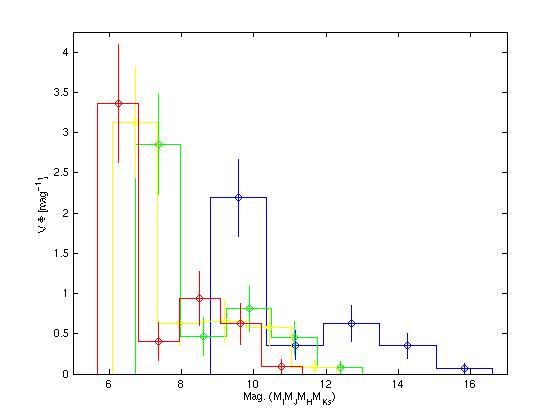
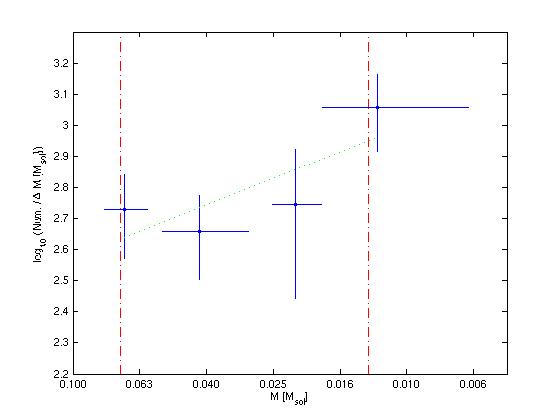
Figure 10:
Left: luminosity function in I (blue), J (green), H
(yellow) and Ks (red) bands.
We have not detected any objects fainter than the completeness magnitudes.
The expected number of objects in the magnitude bin between the completeness and
the limiting magnitudes is between 0 and 1.
Right: mass spectrum for 3 Ma, the most probable age of the cluster. Vertical
dash-dotted lines indicate the hydrogen (right) and deuterium (left) burning
mass limits.

Figure 11:
From left to right, I-, J-, H- and Ks-band images
centred in a new planetary-mass object candidate of the sigma Orionis cluster,
Mayrit J053844.6-025512 (the least massive in our sample).
It is encircled in the J-band image.
It possesses red colours, typical of early-intermediate L spectral type objects
(I-J = 3.50 +/- 0.10 and J-Ks = 1.32 +/- 0.11).
Its derived mass is 7+8-3.
Sizes of the images are 2 times 2 arcmin2.
North is up and east is left.
H- and Ks-band images were taken with O2K.
Summary and conclusions
From our deep IJ-band survey and HK follow-up, we have classified
39 objects as sigma Orionis cluster member candidates in the substellar mass
domain.
Most of them had been previously detected in optical (RIZ) surveys and a
few of them also have spectroscopic features of youth, that guarantees that
those objects are bona-fide cluster members.
We have presented a dozen new substellar object candidates.
Four out of them have the most probable mass in the planetary-mass domain, as
low as 7 MJup.
We have evaluated the slope of the mass spectrum and have found that the number
of objects per interval mass is still rising in the planetary domain.
Our search was complete down to masses lower than the mass of the least massive
detected, and would be able to detect at the limiting magnitudes objects of down
to 3 MJup.
A study of similar depth in a wider area would be desirable to know if the fall
of the luminosity function is due to a real fall in the mass function or that
the covered area was not enough large.
José A. Caballero
Víctor J. S. Béjar
Exoplanetas Gigantes, Enanas
Marrones y Estrellas de Baja Masa
Members of the JOVIAN collaboration:
R. Rebolo, V. J. S. Béjar, J. A. Caballero (Instituto de
Astrofísica de Canarias), D. Barrado y Navascués, M. R. Zapatero
Osorio (LAEFF-INTA, Madrid), R. Mundt, C. A. L. Bailer Jones
(Max-Planck-Institut fuer Astronomie), J. Eisloeffel (Thueringer
Landessternwarte Tautenburg) and T. Forveille (Canada-France-Hawai'i Telescope).
July 2005















